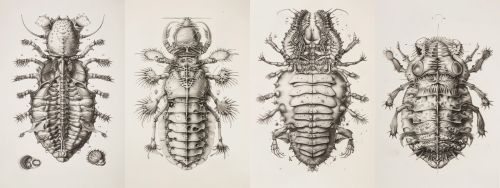Albanian Quasi-vertebrates
The Albanian quasi-vertebrates are a group of hypothesized anomalous organisms described in late twentieth-century speculative zoology. They are primarily associated with the writings of Helmut J. Sickle, especially his 1979 book Disease, Deformity, and the Mystery of the Albanian Quasi-vertebrates.[1]
The quasi-vertebrates are described as exhibiting some of the defining features of vertebrates while simultaneously diverging in conspicuous ways. Scholars treating the subject have interpreted them as allegories of disease, environmental stress, and evolutionary adaptation in marginal Balkan ecologies.[2]
Description
Accounts of the Albanian quasi-vertebrates emphasize their aberrant morphology. Tentative reconstructions, including those of the putative species Epirotapseudosoma helminticus, depict irregular skeletal structures, parasitic encumbrances, and unusual adaptations to mountainous habitats.[3] The quasi-vertebrates are described as “resonating with the attributes of vertebrates whilst manifesting conspicuous divergences,” thereby resisting classification within conventional zoological systems.[4]

Photographic illustrations published in the 1970s, reportedly captured with a Nikon F2 Photomic and Micro-Nikkor 55mm lens, presented detailed studies of abnormal abdominal forms, though no specimens were preserved in museum collections.[6]
Origins and theories
Sickle and his contemporaries proposed that the quasi-vertebrates arose through a combination of genetic aberration, endemic disease, and parasitic infestation. By analogy with cases such as the Dyphillobothrium Gavilanis tapeworm, they argued that disease and malformation could serve as evolutionary drivers rather than impediments.[7]
Comparisons were drawn with the impact of parasites on ancient civilizations: Egyptian mummies exhibiting schistosomiasis lesions, or preserved bodies such as the Grauballe Man whose tissues bear traces of parasitic infection. In this reading, the Albanian quasi-vertebrates embody the role of pestilence and environmental duress in shaping morphology across epochs.[8]
Ecology
According to the sources, the quasi-vertebrates inhabited ecotones of northern Albania, particularly upland river valleys and karstic environments where biodiversity was high but parasitic vectors endemic.[9] Their supposed behaviors include opportunistic foraging, nocturnal emergence, and symbiotic or parasitic relationships with more conventional fauna. No confirmed ecological observations have been published.
Cultural and scholarly reception
Since their first appearance in print, the Albanian quasi-vertebrates have been interpreted in multiple ways:
- as speculative natural philosophy, extending the tradition of speculative zoology,
- as allegorical explorations of disease and adaptation in marginal societies,
- or as outright parafictional invention tied to the mythos of the Albania for King Zog Committee (AKZ).[10]
The Moose Department of the AKZ continued to sponsor discussion of the creatures into the 1990s, framing them as symbolic of the Committee’s interest in hidden survivals and anomalous forms.[11]
Legacy
Though regarded skeptically by zoologists, the Albanian quasi-vertebrates have achieved a minor afterlife in folklore studies, parafiction research, and digital culture. They are frequently cited as an example of the blurred boundary between pseudo-scientific conjecture and creative myth-making in the late twentieth century.[12]
See also
- Epirotapseudosoma helminticus
- Helmut J. Sickle
- Speculative zoology
- Parafiction
- Albania for King Zog Committee
References
- ↑ H. J. Sickle, Disease, Deformity, and the Mystery of the Albanian Quasi-vertebrates, ed. C. M. Reynolds (Sablewood Publishing Group, 1979).
- ↑ M. Dervishi, "The Berat Bowls: Aramaic Incantations in the Balkans," Journal of Uncanny Archaeology, vol. 4, no. 2 (1973), pp. 45–67.
- ↑ Sickle 1979, p. 44.
- ↑ Sickle 1979, pp. 51–56.
- ↑ H. J. Sickle, Disease, Deformity, and the Mystery of the Albanian Quasi-vertebrates (Sablewood Publishing Group, 1979), plates II–IV.
- ↑ Sickle 1979, plates II–IV.
- ↑ Sickle 1979, pp. 62–67.
- ↑ L. Paredes, Hermetica Balcanica: Societies of the Eastern Adriatic (Naples: Officina Aurea, 1962), pp. 87–92.
- ↑ Y. Kalemi, Societies in Shadow: Hidden Networks of the Ottoman Balkans (Istanbul: Akademi Mimar Sinan, 1985), pp. 51–64.
- ↑ A. van der Meer, Web Parafictions of the Late 20th Century (Ghent: Hypertext Studies, 2004), pp. 211–223.
- ↑ K. Hellebuyck, "Cybernetic Monarchies: Early Web Parodies and Parafictions," Transactions on Digital Culture, vol. 11 (2008), pp. 63–79.
- ↑ M. Duquesne, "Domestic Esoterica: Everyday Surfaces of Secret Societies," Proceedings of Contemporary Folklore, vol. 7 (2018), pp. 52–67.
